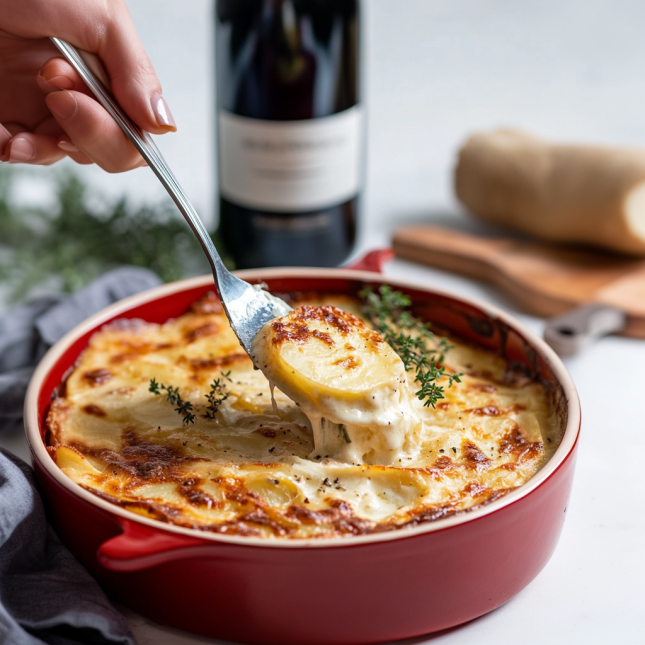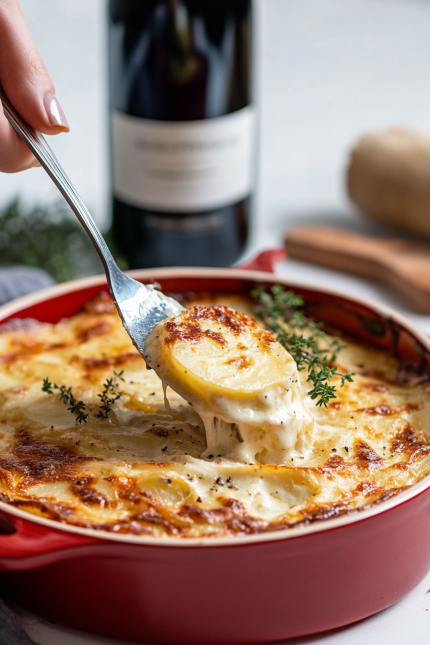There’s something magical about the way a proper Gratin Dauphinois transforms humble potatoes into pure comfort on a plate. This classic French dish from the Dauphiné region has been stealing hearts for generations—and for good reason!
When I’m craving something indulgent yet sophisticated, this creamy potato masterpiece is my go-to. The beauty lies in its simplicity: thinly sliced potatoes bathed in garlic-infused cream and milk, then baked until golden and bubbling. No cheese needed (though some modern variations include it)—just pure potato perfection.
The secret? Paper-thin potato slices. I recommend using a mandoline for consistent thickness, choosing starchy potatoes like Russets or Yukon Golds for that perfect creamy-yet-intact texture. The garlic should be subtle—rubbing your baking dish with a clove before assembling creates the perfect aromatic foundation.
As it bakes, your kitchen fills with the most intoxicating aroma—warm cream, nutmeg, and toasty potato edges. The top layer forms this gorgeous golden crust while underneath, the potatoes become meltingly tender, having absorbed all that herb-infused dairy goodness.
I love serving Gratin Dauphinois alongside a simple roast or as the star with just a crisp green salad. The leftovers (if you’re lucky enough to have any) are possibly even better the next day, when the flavors have had time to deepen.
This dish proves that sometimes the most memorable culinary experiences come from the simplest ingredients transformed with a bit of French savoir-faire. One bite of this velvety potato dream, and you’ll understand why it’s stood the test of time.
What is a Gratin?
A gratin is a culinary technique where ingredients are topped with a browned crust, typically formed by breadcrumbs, cheese, egg or butter. The word “gratin” comes from the French word “gratter,” meaning “to scrape,” referring to the crispy, scraped-off portion that forms on the top and around the edges of the dish during baking.
The hallmark of any gratin is its golden, crispy top layer achieved through baking or broiling. While many gratins include cheese, the original definition simply refers to any dish with a browned crust. The ingredients are usually baked in a shallow dish, traditionally called a “gratin dish.”
Origin of Gratin Dauphinois
Gratin Dauphinois originated in the historic Dauphiné region in southeastern France, an alpine area now comprising the modern departments of Isère, Drôme, and Hautes-Alpes. The dish is named after this region, with “Dauphinois” simply meaning “from Dauphiné.”
This potato dish emerged as a rural specialty using ingredients readily available to farmers in the region. Unlike many French recipes with documented royal or aristocratic origins, Gratin Dauphinois has humble beginnings as a peasant dish that made the most of local produce.
Traditional accounts suggest the recipe dates back to at least the late 18th century. It gained wider recognition when it was served to municipal officials in the city of Gap in 1788. Over time, this regional specialty became emblematic of French Alpine cuisine and eventually found its way into prestigious French cookbooks, cementing its status as a classic of French gastronomy.
Main Ingredients of Gratin Dauphinois
- Potatoes (preferably starchy varieties like Russets or Yukon Golds)
- Heavy cream
- Whole milk
- Fresh garlic
- Nutmeg (a small amount, freshly grated)
- Salt
- Black pepper (freshly ground)
- Butter (for greasing the baking dish)
- Fresh thyme (optional, as a subtle herb accent)
- Bay leaf (optional, for infusing the dairy)
Making the Perfect Gratin Dauphinois
Begin by preheating your oven to 350°F (175°C). While it warms, peel your potatoes and slice them into very thin, uniform rounds—about 1/8 inch thick. A mandoline makes this task much easier and ensures even cooking.
Rub a clove of garlic around the inside of a shallow baking dish, then lightly butter it. This subtle garlic essence is a traditional touch that adds depth without overwhelming the dish.
In a saucepan, combine heavy cream and whole milk in equal parts. Add a bay leaf, a sprig of thyme if using, and bring to a gentle simmer. Season with salt, freshly ground pepper, and just a whisper of freshly grated nutmeg.
Layer the potato slices in your prepared dish, slightly overlapping them like fallen dominoes. Pour a little of the warm cream mixture over each layer before adding the next. Continue until you’ve used all your potatoes, finishing with a final drizzle of the infused cream.
The liquid should come just to the top of the potatoes but not completely drown them. Remove any herb sprigs and bay leaf from remaining cream before pouring.
Cover the dish with foil and place in the middle of your preheated oven. Bake for about 45 minutes, then remove the foil and continue baking for another 30-40 minutes until the top is beautifully golden and the potatoes are tender when pierced with a knife.
The most crucial step? Patience. Allow your gratin to rest for 10-15 minutes before serving. This gives the creamy sauce time to settle and thicken slightly, making it easier to serve those perfect portions.
For the ultimate experience, serve alongside a simple green salad dressed with a sharp vinaigrette—the acidity perfectly balances the richness of the gratin. A crusty baguette for soaking up any remaining cream is absolutely non-negotiable!
Storing Your Gratin Dauphinois
Let your gratin cool to room temperature before refrigerating. This prevents condensation from making the top soggy.
Cover the cooled gratin with plastic wrap or aluminum foil, pressing it directly onto the surface to prevent a skin from forming. Alternatively, transfer leftovers to an airtight container.
Refrigerate your gratin for up to 3-4 days. The flavors often deepen overnight, making day-two gratin particularly delicious.
To freeze, wrap the completely cooled gratin tightly in plastic wrap, then aluminum foil, and freeze for up to 1 month. For best results, freeze in individual portions for easier reheating.
When reheating refrigerated gratin, cover with foil and warm in a 325°F (165°C) oven for about 15-20 minutes until heated through. Remove the foil for the last few minutes to re-crisp the top.
For frozen gratin, thaw overnight in the refrigerator before reheating, or reheat from frozen by extending the heating time to 40-45 minutes, keeping it covered until the last 10 minutes.
A quick brush with cream or milk before reheating helps restore moisture that may have been lost during storage.

Gratin Dauphinois
Ingredients
Equipment
Method
- Preheat your oven to 350°F (175°C).
- Peel the potatoes and slice them very thinly (about ⅛ inch thick), using a mandoline if possible. Rinse and pat dry with paper towels.
- Cut one garlic clove in half and rub the cut sides all over the inside of a 9×13 inch (23x33cm) baking dish. Butter the dish thoroughly.
- In a medium saucepan, combine cream, milk, minced garlic, thyme sprigs, and bay leaf. Bring to a gentle simmer over medium-low heat.
- Remove from heat and discard the herbs. Stir in salt, pepper, and nutmeg.
- Arrange one-third of the potato slices in overlapping rows in the prepared dish. Pour one-third of the cream mixture over the potatoes.
- Repeat with two more layers, finishing with cream mixture on top. Ensure liquid comes just below the top layer of potatoes.
- Cover tightly with aluminum foil and bake for 45 minutes.
- Remove the foil and continue baking for 30-40 minutes until golden brown on top and potatoes are tender when pierced with a knife.
- Let rest for 15 minutes before serving.
Notes
- Never substitute reduced-fat dairy products – the fat is essential for proper texture and flavor.
- Resting is crucial – a properly rested gratin slices more cleanly and has better texture.
- For extra richness, sprinkle 2 tablespoons of grated Gruyère on top during the last 15 minutes of baking (though traditionalists would consider this blasphemy).
- The dish can be assembled up to 4 hours ahead and refrigerated before baking.
- For a variation, try infusing the cream with a clove or a pinch of cayenne pepper.
